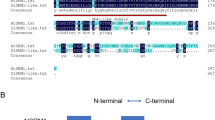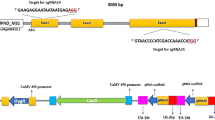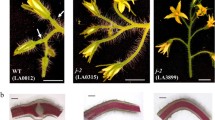Abstract
The entire (e) locus of tomato (Solanum lycopersicum L.) controls leaf morphology. Dominant E and recessive e allele of the locus produce pinnate compound and complex reduced leaves. Previous research had indicated that SlIAA9, an Aux/IAA gene, was involved in tomato leaf morphology. Down-regulation of SlIAA9 gene by antisense transgenic method decreased the leaf complex of tomato and converted tomato compound leaves to simple leaves. The leaf morphology of these transgenic lines was similar with leaf morphology of tomato entire mutant. In this paper, we report that a single-base deletion mutation in the coding region of SlIAA9 gene results in tomato entire mutant phenotypes.








Similar content being viewed by others
References
Abel S, Theologis A (1995) A polymorphic bipartite motif signals nuclear targeting of early auxin-inducible proteins related to PS-IAA4 from pea (Pisum sativum). Plant J 8:87–96
Abel S, Oeller PW, Theologis A (1994) Early auxin-induced genes encode short-lived nuclear proteins. Proc Natl Acad Sci USA 91:326–330
Abel S, Nguyen MD, Theologis A (1995) The PS-IAA4/5-like family of early auxin-inducible mRNAs in Arabidopsis thaliana. J Mol Biol 251:533–549
Colon-Carmona A, Chen DL, Yeh KC, Abel S (2000) Aux/IAA proteins are phosphorylated by phytochrome in vitro. Plant Physiol 24:1728–1738
Dharmasiri N, Dharmasiri S, Estelle M (2005) The F-box protein TIR1 is an auxin receptor. Nature 435:441–445
Eshed Y, Zamir D (1995) An introgression line population of Lycopersicon pennellii in the cultivated tomato enables the identification and fine mapping of yield-associated QTL. Genetics 141:1147–1162
Friml J (2003) Auxin transport-shaping the plant. Curr Opin Plant Biol 6:7–12
Fukaki H, Tameda S, Masuda H, Tasaka M (2002) Lateral root formation is blocked by a gain-of-function mutation in the SOLITARY-ROOT/IAA14 gene of Arabidopsis. Plant J 29:153–168
Fulton TM, Chunwongse H, Tanksley SD (1995) Microprep protocol for extraction of DNA from tomato and other herbaceous plant. Plant Mol Biol Rep 13:207–209
Guilfoyle TJ (1999) Auxin-regulated genes and promoters. In: Hooykaas PJJ, Hall M, Libbenga KL (eds) Biochemistry and molecular biology of plant hormones, Elsevier, Leiden, pp. 423–459
Hamann T, Benkova E, Baurle I, Kientz M, Jurgens G (2002) The Arabidopsis BODENLOS gene encodes an auxin response protein inhibiting MONOPTEROS-mediated embryo patterning. Genes Dev 16:1610–1615
Hareven D, Gutfinger T, Parnis A, Eshed Y, Lifschitz E (1996) The making of a compound leaf: genetic manipulation of leaf architecture in tomato. Cell 84:735–744
Hoffman NE, Ko K, Milkowski D, Pichersky E (1991) Isolation and characterization of tomato cDNA and genomic clones encoding the ubiquitin gene, Ubi3. Plant Mol Biol 17:1189–1201
Kepinski S, Leyser O (2005) The Arabidopsis F-box protein TIR1 is an auxin receptor. Nature 435:446–451
Kessler S, Kim M, Pham T, Weber N, Sinha N (2001) Mutations altering leaf morphology in tomato. Int J Plant Sci 162:475–492
Kim BC, Soh MS, Kang BG, Furuya M, Nam HG (1996) Two dominant photomorphogenic mutations of Arabidopsis thaliana identified as suppressor mutations of hy2. Plant J 15:441–456
Kim M, Pham T, Hamidi A, McCormick S, Kuzoff RK, Sinha N (2003) Reduced leaf complexity in tomato wiry mutants suggests a role for PHAN and KNOX genes in generating compound leaves. Development 130:4405–4415
Menda N, Semel Y, Peled D, Eshed Y, Zamir D (2004) In silico screening of a saturated mutation library of tomato. Plant J 38:861–872
Nagpal P, Walker LM, Young JC, Sonawala A, Timpte C, Estelle M, Reed JW (2000) AXR2 encodes a member of the Aux/IAA protein family. Plant Physiol 123:563–574
Nebenfuhr A, White TJ, Lomax TL (2000) The diageotropica mutation alters auxin induction of a subset of the Aux/IAA gene family in tomato. Plant Mol Biol 44:73–84
Ouellet F, Overvoorde PJ, Theologis A (2001) IAA17/AXR3: biochemical insight into auxin mutant phenotype. Plant Cell 13:829–842
Overvoorde PJ, Okushima Y, Alonso JM, Chan A, Chang C, Ecker JR, Hughes B, Liu A, Onodera C, Quach H, Smith A, Yu G, Theologis A (2005) Functional genomic analysis of the AUXIN/INDOLE-3-ACETIC ACID gene family members in Arabidopsis thaliana. Plant Cell 17:3282–3300
Park JY, Kim HJ, Kim J (2002) Mutation in domain II of IAA1 confers diverse auxin-related phenotypes and represses auxin activated expression of Aux/IAA genes in steroid regulator-inducible system. Plant J 32:669–683
Reed JW (2001) Roles and activities of Aux/IAA proteins in Arabidopsis. Trends Plant Sci 6:420–425
Rick CM, Butler L (1956) Cytogenetics of tomato. Adv Genet 7:267–382
Rogg LE, Lasswell J, Bartel B (2001) A gain-of-function mutation in IAA28 suppresses lateral root development. Plant Cell 13:465–480
Rouse D, Mackay P, Stirnberg P, Estelle M, Leyser O (1998) Changes in auxin response from mutations in an AUX/IAA gene. Science 279:1371–1373
Tanksley SD, Ganal MW, Prince JP, Vicente MC, Bonierbale MW, Broun P, Fulton PM, Giovannoni JJ, Grandillo S, Martin GB, Messeguer R, Miller JC, Miller L, Paterson AH, Pineda O, Röder MS, Wing RA, Wu M, Young ND (1992) High density molecular linkage maps of the tomato and potato genomes. Genetics 132:1141–1160
Tatematsu K, Kumagai S, Muto H, Sato A, Watahiki MK, Harper RM, Liscum E, Yamamoto KT (2004) MASSUGU2 encodes Aux/IAA19, an auxin-regulated protein that functions together with the transcriptional activator NPH4/ARF7 to regulate differential growth responses of hypocotyl and formation of lateral roots in Arabidopsis thaliana. Plant Cell 16:379–393
Tian Q, Reed JW (1999) Control of auxin-regulated root development by the Arabidopsis thaliana SHY2/IAA3 gene. Development 126:711–721
Tian Q, Uhlir NJ, Reed JW (2002) Arabidopsis SHY2/IAA3 inhibits auxin-regulated gene expression. Plant Cell 14:301–319
Tiwari SB, Hagen G, Guilfoyle TJ (2004) Aux/IAA proteins contain a potent transcriptional repression domain. Plant Cell 16:533–543
Vogler H, Kuhlemeier C (2003) Simple hormones but complex signalling. Curr Opin Plant Biol 6:51–56
Wang H, Jones B, Li ZG, Frasse P, Delalande C, Regad F, Chaabouni S, Latche A, Pech JC, Bouzayen M (2005) The tomato Aux/IAA transcription Factor IAA9 is involved in fruit development and leaf morphogenesis. Plant Cell 17:2676–2692
Yang XQ, Lee SS, So J, Dharmasiri S, Dharmasiri N, Ge L, Jensen C, Hangarter R, Hobbie L, Estelle M (2004) The IAA1 protein is encoded by AXR5 and is a substrate of SCFTIR1. Plant J 40:772–782
Acknowledgments
The authors thank TGRC at UC Davis, USA, and Zamir lab at the Hebrew University in Jerusalem, Israel, for supplying tomato seeds of IL population, entire mutants and entire allelic mutant; and Dr. Zhangjun Fei (Boyce Thompson Institute for Plant Research, Cornell University, Ithaca, NY, USA) for reading this manuscript. This research was supported by a grant from the National Natural Science Foundation of China (No. 30671416).
Author information
Authors and Affiliations
Corresponding author
Rights and permissions
About this article
Cite this article
Zhang, J., Chen, R., Xiao, J. et al. A single-base deletion mutation in SlIAA9 gene causes tomato (Solanum lycopersicum) entire mutant. J Plant Res 120, 671–678 (2007). https://doi.org/10.1007/s10265-007-0109-9
Received:
Accepted:
Published:
Issue Date:
DOI: https://doi.org/10.1007/s10265-007-0109-9




